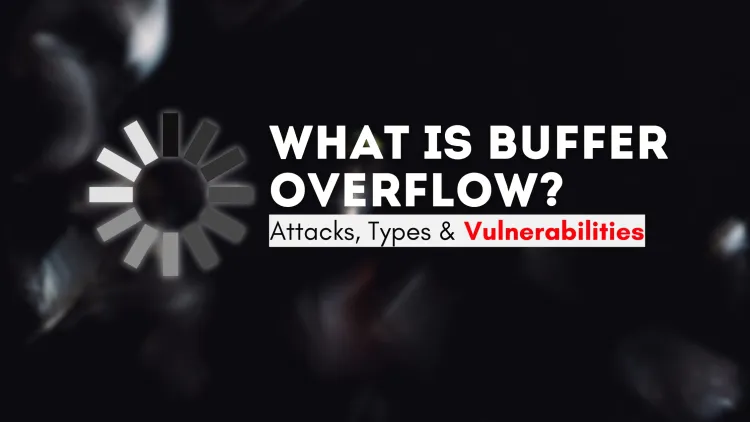What Is Buffer Overflow? Attacks, Types & Vulnerabilities
A buffer overflow occurs when a program writes more data to a buffer than it can handle, leading to memory corruption and potential system compromise. Attackers exploit this vulnerability to execute malicious code, steal sensitive data, or crash applications. Common types include stack-based, heap-based, and format string attacks. To detect and prevent buffer overflow attacks, developers can use input validation, secure coding practices, and tools like ASLR, stack canaries, and static analysis. Understanding and mitigating buffer overflows are crucial for maintaining system security and preventing potential breaches.

In the world of cybersecurity, a buffer overflow is a critical vulnerability that occurs when a program writes more data to a buffer than it can hold. This leads to data overwriting adjacent memory locations, potentially exposing the system to malicious attacks. Understanding buffer overflows, their types, and how attackers exploit them is essential for developers and cybersecurity professionals.
What Is Buffer Overflow?
A buffer is a temporary storage space in a program’s memory used to hold data. A buffer overflow happens when the program exceeds the buffer’s storage capacity, causing data to spill over into adjacent memory locations. This can lead to:
- Corrupted data
- Unexpected program behavior
- Execution of malicious code
How Do Buffer Overflow Attacks Work?
Attackers exploit buffer overflows by deliberately sending more data than a buffer can handle. This allows them to:
- Overwrite critical memory locations
- Inject and execute malicious code
- Gain unauthorized access to the system
For example, in a vulnerable application, an attacker might input a string longer than the program expects, causing the program to crash or execute injected commands.
Types of Buffer Overflow Attacks
1. Stack-Based Buffer Overflow
This is the most common type of buffer overflow. It occurs in the call stack, where data like function parameters and local variables are stored. An attacker can overwrite the return address of a function, redirecting execution to malicious code.
2. Heap-Based Buffer Overflow
This type occurs in the heap memory used for dynamic allocations. Attackers exploit this by overwriting function pointers or object metadata, leading to unauthorized code execution.
3. Format String Vulnerabilities
These occur when a program improperly handles format string inputs, allowing attackers to read or write arbitrary memory locations.
Common Vulnerabilities Leading to Buffer Overflows
-
Lack of Input Validation
Programs that don’t properly check input sizes are susceptible to buffer overflows. -
Insecure Functions
Using functions likestrcpyandgetsin C/C++ can lead to buffer overflows if input size isn’t verified. -
Improper Memory Management
Failing to allocate and manage memory correctly can result in overflows. -
Unchecked Loops or Recursion
Loops or recursive functions without proper exit conditions may cause stack overflows.
Examples of Real-World Buffer Overflow Attacks
1. Morris Worm (1988)
The first major internet worm exploited a buffer overflow vulnerability in the finger daemon to spread rapidly.
2. Heartbleed Bug (2014)
A vulnerability in OpenSSL’s implementation of the TLS heartbeat extension allowed attackers to read sensitive data from server memory.
3. Blaster Worm (2003)
This worm exploited a buffer overflow in Microsoft’s RPC service to propagate across networks.
Detection and Prevention of Buffer Overflows
Detection Methods
-
Static Analysis Tools
Analyze source code to identify potential vulnerabilities. -
Dynamic Testing
Tools like fuzzers inject random data into applications to detect buffer overflows. -
Code Reviews
Manual reviews help identify insecure code practices.
Prevention Techniques
-
Input Validation
Validate all inputs to ensure they fit within buffer limits. -
Use Secure Functions
Replace vulnerable functions likestrcpywith safer alternatives likestrncpy. -
Implement Stack Canaries
Special values placed between buffers and control data to detect overflows. -
Address Space Layout Randomization (ASLR)
Randomizes memory addresses to make it harder for attackers to predict exploit targets. -
Compile-Time Protections
Use modern compilers with built-in buffer overflow protections like-fstack-protector.
Why Are Buffer Overflows Dangerous?
Buffer overflows are dangerous because they allow attackers to take control of the system. They can:
- Execute arbitrary code
- Steal sensitive data
- Crash applications, leading to denial of service (DoS)
- Escalate privileges and gain full system access
Conclusion
Buffer overflows remain a significant threat in cybersecurity. Understanding the types, vulnerabilities, and methods for detection and prevention is crucial for safeguarding applications and systems. By following secure coding practices and implementing modern protective measures, developers and organizations can mitigate the risks associated with buffer overflow attacks.
FAQs
-
What is a buffer overflow?
A buffer overflow occurs when a program writes more data to a buffer than it can hold, leading to memory corruption. -
Why are buffer overflows dangerous?
They allow attackers to execute malicious code, steal data, or crash applications. -
What are common types of buffer overflows?
Stack-based, heap-based, and format string vulnerabilities. -
How do attackers exploit buffer overflows?
By sending more data than a buffer can handle, they overwrite critical memory locations. -
What tools detect buffer overflow vulnerabilities?
Static analysis tools, dynamic testing (fuzzers), and code reviews. -
How can buffer overflows be prevented?
Use input validation, secure functions, stack canaries, and ASLR. -
What is the difference between stack and heap overflows?
Stack overflows occur in the call stack, while heap overflows occur in dynamically allocated memory. -
What are some real-world examples of buffer overflow attacks?
The Morris Worm, Heartbleed Bug, and Blaster Worm are notable examples. -
Why is input validation important in preventing buffer overflows?
It ensures that input data fits within buffer limits, preventing overflow. -
What is ASLR, and how does it help?
Address Space Layout Randomization randomizes memory locations, making it harder for attackers to predict and exploit vulnerabilities.











![Top 10 Ethical Hackers in the World [2025]](https://www.webasha.com/blog/uploads/images/202408/image_100x75_66c2f983c207b.webp)



![[2025] Top 100+ VAPT Interview Questions and Answers](https://www.webasha.com/blog/uploads/images/image_100x75_6512b1e4b64f7.jpg)







